What is a Portable Iridology Device?
A portable iridology device is a specialized tool designed to capture high-resolution images of the iris for health assessment purposes. Unlike traditional stationary iridology systems that require dedicated space and setup, these portable alternatives offer flexibility and convenience without sacrificing essential functionality. Modern portable iridology devices typically combine optical magnification technology with digital imaging capabilities, allowing practitioners to examine iris patterns in detail and store images for future reference.
These devices have revolutionized the practice of iridology by making it possible to conduct examinations virtually anywhere – from health clinics and wellness centers to home consultations and mobile health services. The compact nature of a portable iridology device makes it an attractive option for practitioners who travel between locations or those with limited office space.
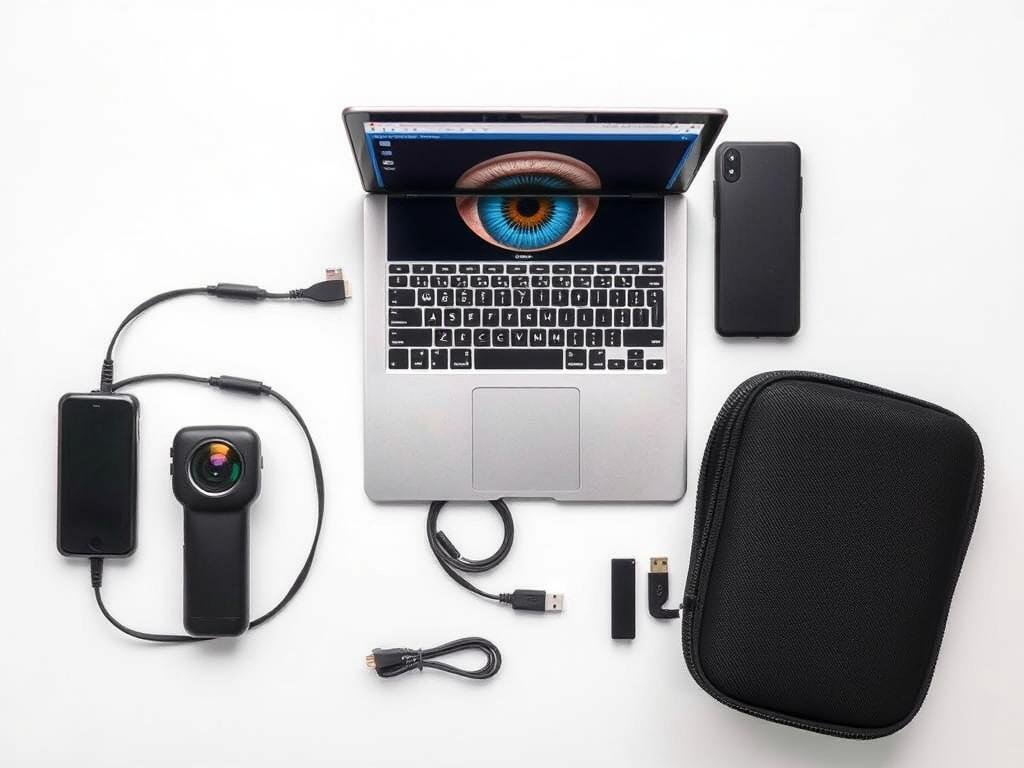
Key components of a standard Portable Iridology Device system
How Does a Portable Iridology Device Work?
The operation of a portable iridology device follows a straightforward process that combines optical and digital technologies:
- The device uses specialized illumination (typically LED lights) to provide consistent, glare-free lighting of the iris
- A high-magnification lens (commonly 30x iris lens) captures detailed images of the iris structure
- The integrated digital camera (ranging from 5MP to 12MP) records these images at high resolution
- The captured images are transferred to a computer via USB connection or wireless technology
- Specialized iridology software analyzes the images, identifying patterns and markings according to iridology principles
- The software may generate reports highlighting areas of interest based on iridology mapping
Most portable iridology devices feature adjustable focus mechanisms and light intensity controls to optimize image quality across different eye colors and lighting conditions. The integration with analysis software is what transforms these devices from simple magnifiers to comprehensive health assessment tools.

Practical application of a Portable Iridology Device in a clinical setting
Key Components of Modern Portable Iridology Devices
Today’s portable iridology devices incorporate several essential components that determine their functionality and effectiveness:
Optical System
- 30x iris lens for detailed magnification
- LED illumination system with adjustable brightness
- Color temperature filters for accurate iris color representation
- Optical image stabilizers for clearer images
Digital Components
- High-resolution CMOS or CCD image sensors (5-12MP)
- Digital signal processors for image enhancement
- USB or wireless connectivity options
- Internal memory for image storage (in some models)
Software Features
- Iris analysis software with mapping capabilities
- Patient/client database management
- Comparison tools for tracking changes over time
- Report generation and printing functionality
Physical Design
- Ergonomic handheld form factor
- Lightweight construction for portability
- Protective casing for transport
- Battery power options (in wireless models)
The quality and integration of these components significantly impact the performance and reliability of a portable iridology device. Higher-end models typically feature superior optics, better image sensors, and more comprehensive software packages, while budget options may prioritize basic functionality and portability.
Need Expert Guidance on Iridology Equipment?
Our specialists can help you understand which portable iridology device features matter most for your specific needs.
در واتساپ با ما تماس بگیرید
Advantages of Using a Portable Iridology Device
The rising popularity of portable iridology devices can be attributed to several significant benefits they offer over traditional stationary systems. These advantages make them particularly valuable for certain practitioners and use cases.

The mobility advantage of Portable Iridology Devices across different practice settings
Convenience and Mobility
Perhaps the most obvious benefit of a portable iridology device is the freedom it provides:
- Location flexibility: Conduct iris examinations anywhere – from dedicated offices to client homes, wellness events, or mobile clinics
- Space efficiency: No need for permanent setup space, making these devices ideal for practitioners with limited office area
- Travel-friendly: Most models come with protective cases and weigh less than 2 pounds, easily fitting in a professional bag
- Quick setup: Connect to a laptop or tablet and begin examinations within minutes, eliminating lengthy preparation time
- Opportunistic assessments: Perform impromptu examinations when needed without scheduling around equipment availability
This mobility transforms how practitioners can deliver iridology services, enabling new business models like mobile wellness consultations or multi-location practices without duplicating expensive equipment.
Cost-Effectiveness Compared to Traditional Systems
The financial advantages of portable iridology devices make them accessible to a wider range of practitioners:
| Cost Factor |
Portable Iridology Device |
Traditional Stationary System |
| Initial Investment |
$150-$500 (basic models)
$500-$1,200 (professional models) |
$2,000-$10,000+ |
| Installation Requirements |
هیچ کدام – plug and play |
Often requires professional setup |
| Space Requirements |
Minimal storage space |
Dedicated examination area |
| Maintenance Costs |
Low – primarily software updates |
بالاتر – regular calibration and servicing |
| Upgrade Path |
Replace entire unit at lower cost |
Expensive component upgrades |
The substantial cost difference makes portable iridology devices particularly attractive for:
- New practitioners just starting their practice
- Holistic health professionals adding iridology as a complementary service
- Educational institutions teaching iridology principles
- Multi-practitioner clinics needing multiple units
طراحی کاربر پسند
Modern portable iridology devices are designed with usability in mind:
Intuitive Operation
- Simple one-button capture mechanisms
- Adjustable focus controls on the handle
- Direct computer connection without complex setup
- LED indicators for optimal positioning
Software Accessibility
- Guided workflow for image capture and analysis
- Automated iris mapping based on established charts
- Client database with simple search functionality
- One-click report generation
This user-friendly approach reduces the learning curve for new practitioners and streamlines the examination process for experienced users. Many portable iridology devices now include tutorial videos and quick-start guides to further enhance usability.
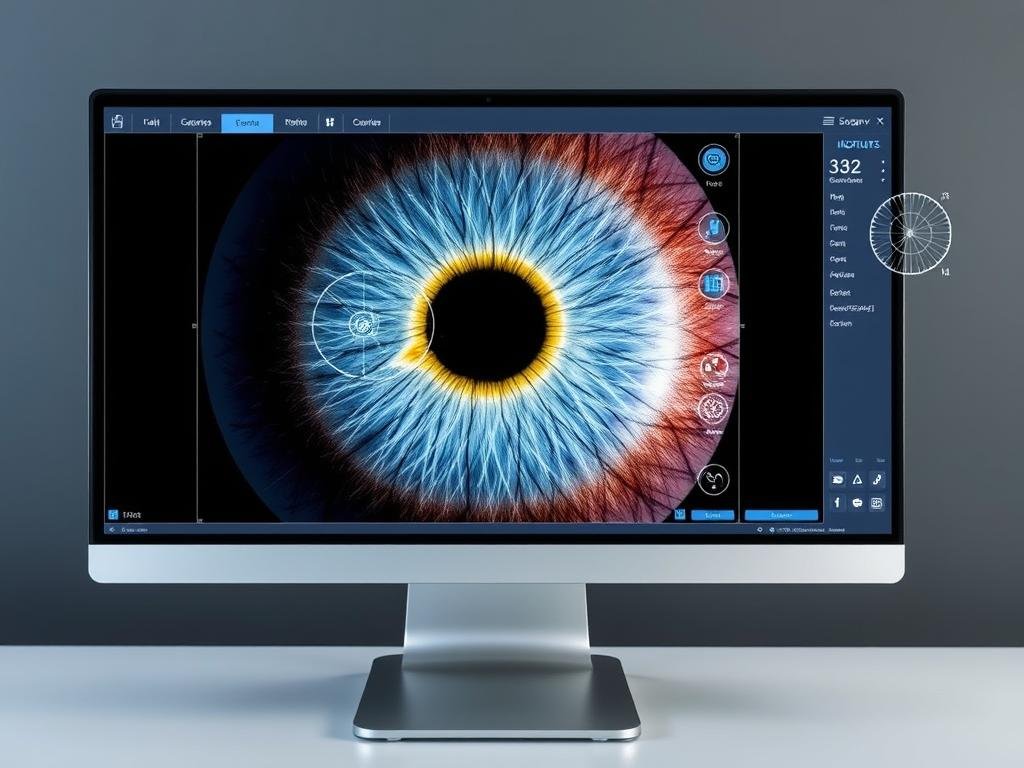
User-friendly software interface commonly included with Portable Iridology Devices
Limitations of Portable Iridology Devices
در حالی که portable iridology devices offer numerous benefits, it’s important to acknowledge their limitations to make an informed decision about their suitability for your needs.

Image quality comparison: Basic Portable Iridology Device (left) vs. Professional System (right)
Accuracy Concerns
The compact nature of portable iridology devices can sometimes impact their diagnostic precision:
Potential Accuracy Limitations
- Lower resolution in budget models (below 8MP) may miss subtle iris details
- Simplified optical systems can introduce minor distortions in iris representation
- Handheld operation may result in inconsistent image capture angles
- Limited illumination options can affect visibility of certain iris features
- Basic software algorithms might provide less comprehensive analysis than professional systems
These accuracy concerns are most pronounced in entry-level portable iridology devices. Professional-grade portable models with higher specifications can significantly mitigate these issues, though they still may not match the precision of top-tier stationary systems.
Limited Advanced Features
To maintain portability and affordability, some features found in professional systems may be absent in portable iridology devices:
- Reduced magnification range: Typically limited to a fixed 30x iris lens rather than variable magnification
- Fewer illumination options: May offer only 2-4 LED lights instead of comprehensive lighting systems
- Basic software capabilities: Simplified analysis tools without advanced diagnostic algorithms
- Limited integration: Fewer options for connecting with other health assessment systems
- Restricted multi-user functionality: May not support complex multi-practitioner workflows
For practitioners who rely heavily on advanced features, these limitations may impact the utility of portable iridology devices for complex assessments.
Battery and Durability Issues
The portable nature of these devices introduces practical considerations:
Power Constraints
- USB-powered models require computer connection
- Battery-powered units have limited operational time
- Power fluctuations can affect illumination consistency
- Charging requirements may interrupt workflow
Durability Concerns
- More vulnerable to damage from drops or impacts
- Sensitive optical components may misalign with rough handling
- Connection ports can wear out with frequent use
- Less robust construction compared to stationary systems
These practical limitations necessitate careful handling and maintenance of portable iridology devices to ensure their longevity and consistent performance.
نکته مهم: در حالی که portable iridology devices offer significant convenience, practitioners should carefully consider these limitations in the context of their specific practice needs and client requirements.
Portable Iridology Device vs. Stationary Iridology Systems
To make an informed decision between portable iridology devices and traditional stationary systems, it’s helpful to directly compare their capabilities across key parameters.

Operational comparison: Portable Iridology Device vs. Stationary System
| ویژگی |
Portable Iridology Device |
Stationary Iridology System |
Best For |
| کیفیت تصویر |
Good to Very Good
(5-12MP resolution) |
Excellent
(12-20MP+ resolution) |
Stationary System |
| Mobility |
Excellent
(Lightweight, compact) |
Poor
(Fixed installation) |
Portable Device |
| Setup Time |
1-2 minutes |
Permanently installed |
Portable Device |
| Image Consistency |
Variable
(Depends on operator skill) |
عالی
(Fixed positioning) |
Stationary System |
| هزینه |
$150-$1,200 |
$2,000-$10,000+ |
Portable Device |
| Software Capabilities |
Basic to Intermediate |
Advanced |
Stationary System |
| Client Comfort |
Good
(Brief examination) |
Excellent
(Stable positioning) |
Stationary System |
| Space Requirements |
Minimal |
Dedicated area needed |
Portable Device |
| Multi-practitioner Use |
Excellent
(Easily shared) |
Limited
(Location-bound) |
Portable Device |
This comparison highlights that portable iridology devices excel in flexibility, affordability, and convenience, while stationary systems offer superior image quality and consistency. The best choice depends on your specific practice requirements, budget constraints, and operational model.
“The ideal solution for many practitioners is to start with a quality portable iridology device and upgrade to a stationary system as their practice grows and specialization increases.”
– Dr. Jensen, Iridology Educator
Not Sure Which System Is Right For You?
Our team can provide personalized recommendations based on your practice needs and budget.
به متخصصان ما ایمیل بزنید
How to Choose the Best Portable Iridology Device
Selecting the right portable iridology device requires careful consideration of several key factors to ensure it meets your specific needs and provides reliable performance.
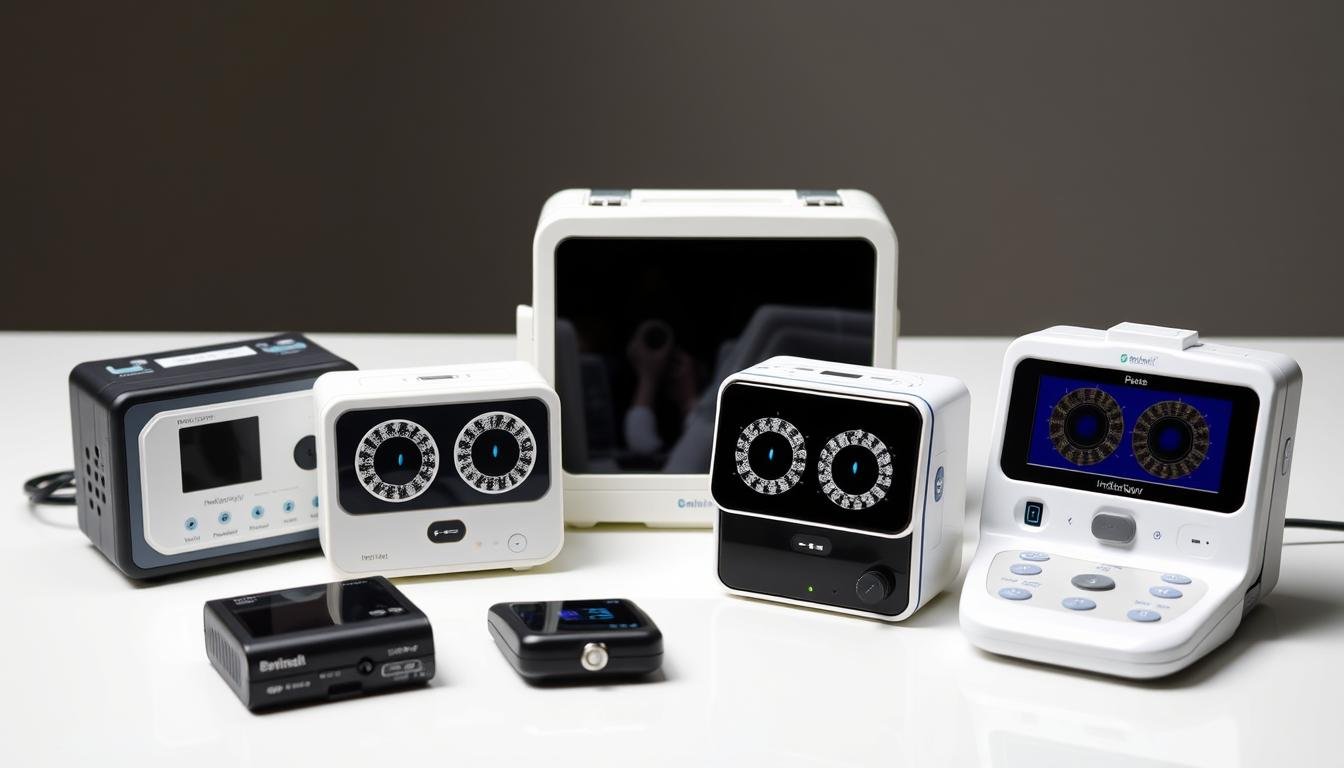
Range of Portable Iridology Devices available at different price points and specifications
Key Features to Prioritize
هنگام ارزیابی portable iridology devices, focus on these critical specifications:
Feature Importance
Illumination Quality
9.0/10
Software Capabilities
8.5/10
Connectivity Options
6.5/10
مشخصات فنی
- Resolution: Minimum 8MP for professional use, 5MP for basic applications
- Lens Quality: 30x iris lens with anti-glare coating
- Illumination: Adjustable LED system with at least 2-4 light sources
- Focus System: Manual or auto-focus capability
- Connectivity: USB 3.0 or faster for wired models; stable wireless connection for others
Software Considerations
- Analysis Tools: Comprehensive iris mapping capabilities
- Database: Client information storage and retrieval
- Compatibility: Works with your operating system (Windows/Mac)
- Updates: Regular software updates and support
- Export Options: Ability to save and share reports in common formats
Practical Considerations
- Weight and Size: Comfortable to hold for extended periods
- Battery Life: Sufficient for a full day of consultations (if wireless)
- Durability: Quality construction that can withstand regular use
- Case/Storage: Protective carrying case included
- Warranty: At least 1-year manufacturer coverage
Support and Training
- Technical Support: Responsive customer service
- Training Materials: Comprehensive user manual and tutorials
- Community: Access to user forums or groups
- Troubleshooting: Clear guidance for common issues
- Upgrade Path: Options for future enhancements
Top Brands to Consider
Several manufacturers have established reputations for quality portable iridology devices:
Professional Grade
- Guangzhou Zhenyuesheng (12MP systems with multi-language software)
- Guangdong Biophilia Tech (Advanced iris analysis capabilities)
- Shenzhen Y-Rising Technology (High-resolution imaging systems)
- Guangdong Sanhong Tech (Multi-function testing systems)
- Hefei JYTOP (Latest version professional software)
Mid-Range Options
- Guangzhou S&A Beauty Equipment (Reliable 5MP systems)
- Shenzhen Nuopuen Technology (Good value for clinics)
- Handan Fushui Technology (Wireless capabilities)
- Guangzhou Qianhe Beauty Equipment (User-friendly interfaces)
- Shaanxi Alisa Technology (Multi-purpose analyzers)
Budget-Friendly
- Basic 5MP USB models (Entry-level functionality)
- Simplified software packages (Core features only)
- Refurbished professional units (Cost savings)
- Educational models (For learning purposes)
- Starter kits with basic accessories
When selecting from these brands, consider your specific practice requirements, budget constraints, and long-term goals. Many practitioners find that investing in a mid-range or professional-grade portable iridology device provides the best balance of quality and value.
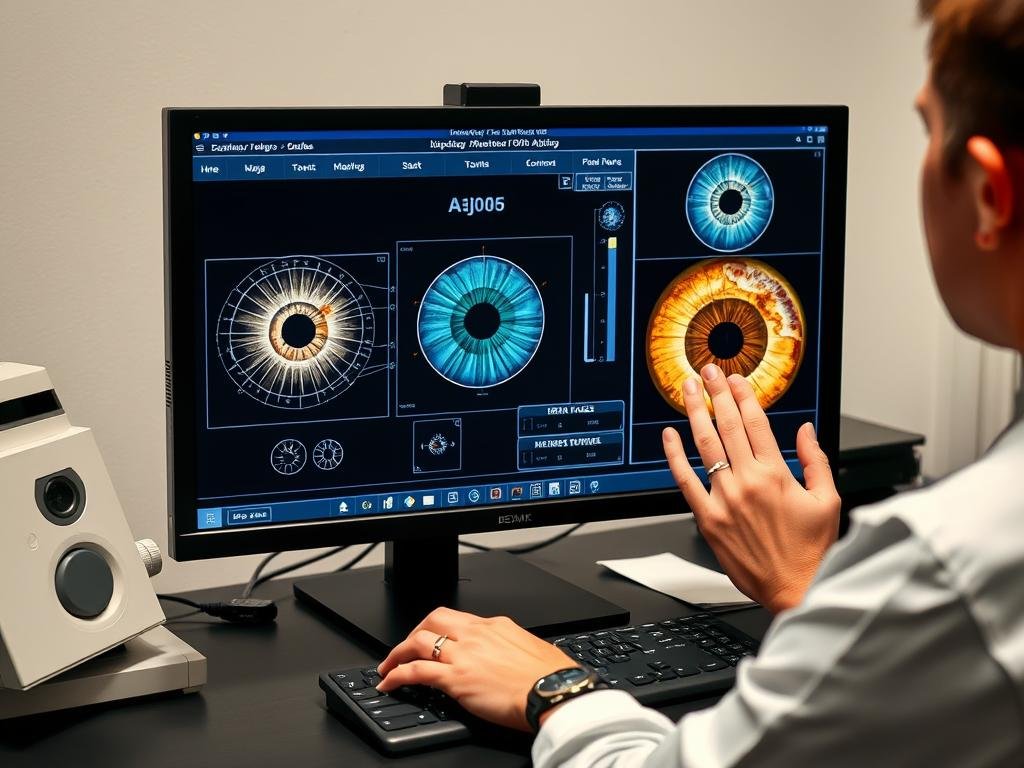
Professional analysis software included with quality Portable Iridology Devices
Ready to Find Your Ideal Iridology Solution?
We offer personalized consultations to match you with the perfect portable iridology device for your practice.
WhatsApp Consultation
Email Inquiry
سؤالات متداول در مورد Portable Iridology Devices
Are portable iridology devices accurate enough for professional use?
Yes, modern professional-grade portable iridology devices with 8MP+ resolution and quality optics provide sufficient accuracy for most professional applications. While they may not match the absolute precision of top-tier stationary systems, they offer excellent detail for standard iridology assessments. The key factors affecting accuracy are resolution, illumination quality, and operator skill. Practitioners should select devices with specifications appropriate for their specific diagnostic needs.
How much technical knowledge is required to use a portable iridology device?
Most portable iridology devices are designed with user-friendliness in mind and require minimal technical expertise. Basic computer skills are sufficient for operating the software, and the physical devices typically feature intuitive controls. Most manufacturers provide comprehensive user manuals, video tutorials, and sometimes initial training. The learning curve focuses more on iridology interpretation skills rather than technical operation of the device itself.
Can portable iridology devices be used for both left and right eyes?
Yes, quality portable iridology devices are designed to capture images of both eyes. Most models feature adjustable illumination that can be switched between left and right sides to provide optimal lighting for each eye. The software accompanying these devices typically allows for side-by-side comparison of both irises, which is essential for comprehensive iridology assessment. Some advanced models even offer split-screen functionality for simultaneous viewing.
What computer specifications are needed to run iridology software?
Most iridology software designed for portable iridology devices has modest system requirements. Typically, a computer with at least 4GB RAM, 100GB free storage space, and a modern processor (i3/i5 or equivalent) is sufficient. Windows 10/11 is the most widely supported operating system, though some software packages offer Mac compatibility. USB 3.0 ports are recommended for faster image transfer with wired devices. Always check the specific requirements for your chosen device’s software to ensure compatibility.
How long do portable iridology devices typically last?
With proper care and maintenance, a quality portable iridology device can last 3-5 years of regular professional use. The most common points of failure are connection ports, illumination systems, and focus mechanisms due to repeated handling. Higher-end models with better build quality naturally tend to have longer operational lifespans. To maximize longevity, practitioners should follow manufacturer guidelines for storage, cleaning, and handling, and always use the provided protective case when transporting the device.
Can portable iridology devices be used without a computer?
Most portable iridology devices require connection to a computer or tablet for operation, as they rely on external software for image processing and analysis. However, some newer models offer limited standalone functionality, with built-in displays for basic image capture and viewing. These standalone capabilities are typically restricted to preliminary examinations, with full analysis still requiring computer software. For comprehensive iridology assessments, a computer connection remains essential for most devices.
Is special training required to interpret the results from a portable iridology device?
Yes, proper interpretation of iris images from a portable iridology device requires specialized knowledge of iridology principles. While the software may provide basic mapping and highlighting of iris features, meaningful interpretation requires understanding of iridology charts, tissue changes, and their potential health correlations. Most manufacturers recommend that users have formal training in iridology or work under the guidance of a trained practitioner. Many professional iridology associations offer certification programs and continuing education.
پایان
Portable iridology devices represent a significant advancement in making iridology more accessible, affordable, and convenient for practitioners across various settings. Their compact design and user-friendly operation open new possibilities for mobile practice, multi-location services, and integration of iridology into diverse health modalities.
While these devices do have limitations compared to their stationary counterparts—particularly in terms of absolute image quality and advanced features—modern professional-grade portable iridology devices offer remarkable capability in a compact package. The best choice ultimately depends on your specific practice needs, budget constraints, and operational model.
For many practitioners, especially those just entering the field or adding iridology as a complementary service, a quality portable iridology device offers an excellent balance of functionality and value. As your practice grows and specializes, you can always consider upgrading to more advanced equipment based on evolving requirements.
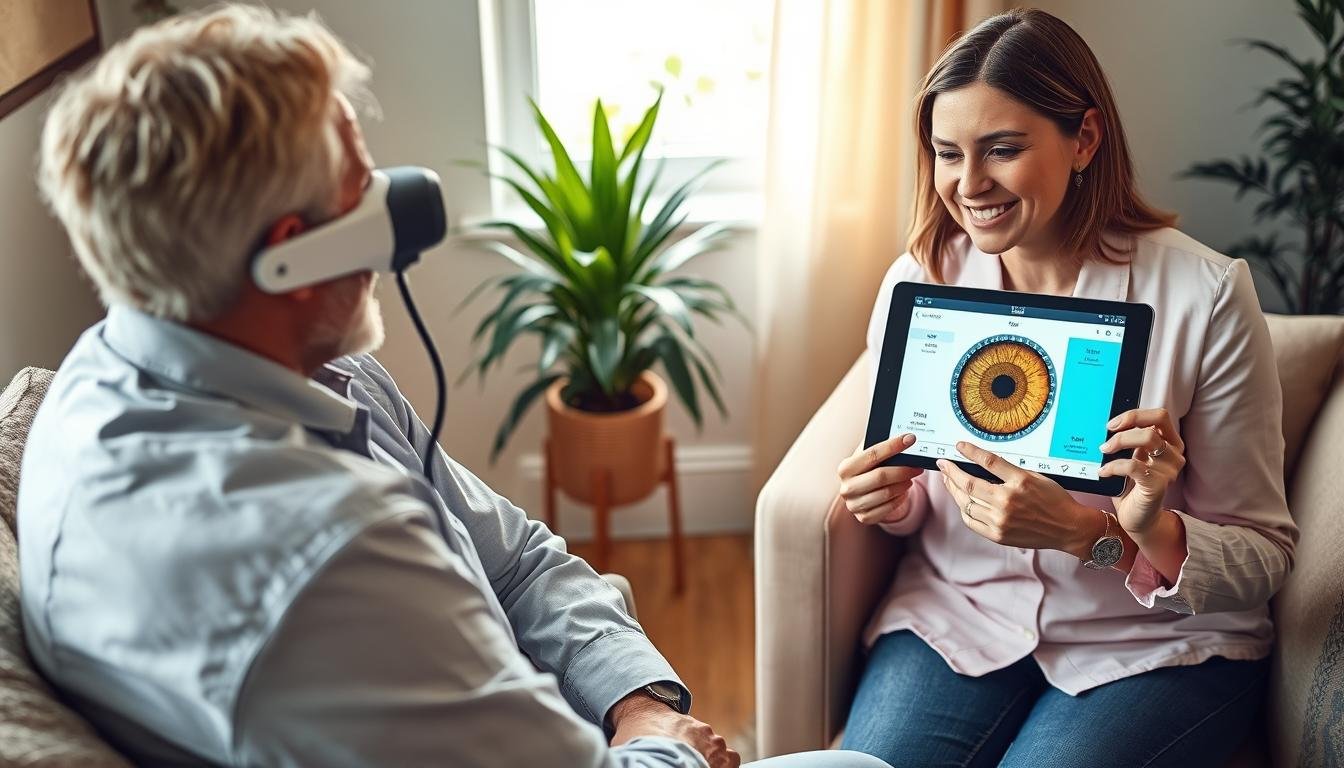
Portable Iridology Devices enable personalized consultations in comfortable settings
Expert Guidance for Your Iridology Practice
Whether you’re just starting out or looking to upgrade your equipment, our specialists can help you find the perfect portable iridology device solution.


































